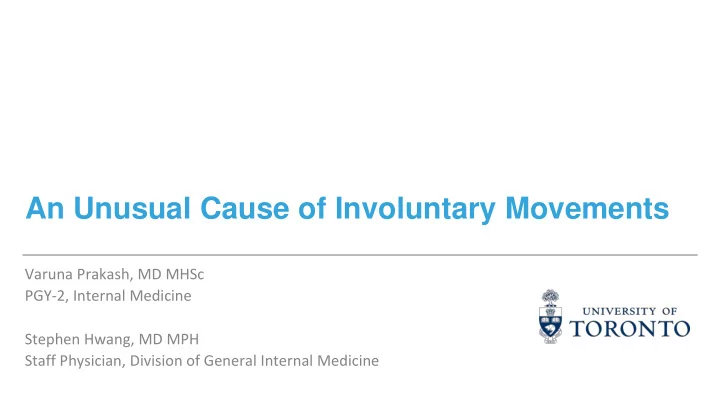

An Unusual Cause of Involuntary Movements Varuna Prakash, MD MHSc PGY-2, Internal Medicine Stephen Hwang, MD MPH Staff Physician, Division of General Internal Medicine
Disclosures & Conflicts of Interest None
The Patient ID: 64 y/o from home alone PMHx: • T2DM (CABG x 4, L corona radiata CVA, L 4 th toe amputation, retinopathy, nephropathy, neuropathy). Last A1C = 10.6 (7 years ago) • Dyslipidemia • CHF-HFpEF • 20 p/y smoking hx Medications: Stopped all Rx meds including insulin 1 year ago. Now using turmeric, apple cider vinegar, ginger. Functional Status: Previously independent for all ADLs, iADLs
Presenting Concern • Fell near Tim Hortons 2 days ago, no LOC, unclear why he fell • Sudden onset of involuntary flinging movements of L arm and leg x 2 days • Now also some uncontrolled tongue movements and mild slurred speech (noticed by sister) • No mental status changes, headaches, facial droop, dysphagia, limb weakness, bowel/bladder dysfunction. • Cardio/Resp/GI/GU/Derm/Constitutional/Exposure RoS negative
On Examination • Vitals: BP 177/74, remainder of VS WNL • Mental Status/Cognition: Normal • CV/Resp/Abdo/Derm: Unremarkable • Neuro: Very abnormal…
On Examination (with consent)
DDx – Involuntary Movements Image adapted from DeLong MR, Wichmann T. Circuits and Circuit Disorders of the Basal Ganglia. Arch Neurol. 2007 Jan 1;64(1):20.
DDx – Involuntary Movements • Vascular: Basal ganglia stroke • Drug or Toxin Induced: Amphetamines, Stimulants, Antipsychotics (TDs) • Infectious: Sydenham’s chorea (GAS), cerebral toxoplasmosis • Autoimmune: SLE (APLA) • Endocrine/Metabolic: Hyperglycemia, various electrolyte dx, chorea gravidarum • Neoplastic/Paraneoplastic: SCC, anti-Hu/Ri/Yo • Neurodegenerative, Demyelinating: Huntington’s Disease Image adapted from DeLong MR, Wichmann T. Circuits and Circuit Disorders of the Basal Ganglia. Arch Neurol. 2007 Jan 1;64(1):20.
Initial Investigations MCV 76 112 Sosm 295 133 91 Troponin 0.006 17 Tox negative 6.7 261 4.2 20 122 7.34 / 30 / 17 Lactate 1.7 Ketones +++
Initial Investigations CT Head: “Multiple old lacunar infarcts. Hyperdensity in the R corpus striatum may be due to underlying hemorrhage or calcium deposition. Consideration of hyperglycemic hemichorea. Is the patient diabetic?”
Non-ketotic Hyperglycemic Hemiballismus-Hemichorea • Also known as Chorea, Hyperglycemia, Basal Ganglia Syndrome (C-H-BG) • Epidemiology: Rare – largest review is of 53 cases 1 Described most often in older (~71 years), female (W30:M17), Asian patients 1 Mean BG: 26 Mean HbA1C: 14.4 • Proposed Pathophysiology: Poorly understood. ?Hyperviscosity/BBB disruption • Diagnosis: MRI shows T1 hyperintensity in striatum, +/- T2 hypointensity • Treatment: Correction of hyperglycemia
Workup & Management • Insulin infusion until Anion Gap closed • MRI confirmed T1-increased signal within R lentiform nucleus and caudate, T2-hyposignal in same area, SWI normal, no acute infarct. • Symptoms resolved! • Discharged home with Metformin, premixed Insulin • Guess the A1C?
After (with consent)
3 Learning Points
Thank you! varuna.prakash@utoronto.ca
References 1. Ondo WG. Hyperglycemic nonketotic states and other metabolic imbalances. In: Handbook of Clinical Neurology [Internet]. Elsevier; 2011 [cited 2018 May 18]. p. 287–91. Available from: http://linkinghub.elsevier.com/retrieve/pii/B9780444520142000215. 2. Narayanan S. Hyperglycemia-Induced Hemiballismus Hemichorea: A Case Report and Brief Review of the Literature. J Emerg Med. 2012 Sep;43(3):442–4. 3. Hansford BG, Albert D, Yang E. Classic neuroimaging findings of nonketotic hyperglycemia on computed tomography and magnetic resonance imaging with absence of typical movement disorder symptoms (hemichorea-hemiballism). J Radiol Case Rep. 2013 Aug;7(8):1–9. 4. Bizet J, Cooper CJ, Quansah R, Rodriguez E, Teleb M, Hernandez GT. Chorea, Hyperglycemia, Basal Ganglia Syndrome (C-H-BG) in an uncontrolled diabetic patient with normal glucose levels on presentation. Am J Case Rep. 2014;15:143– 6. 5. Cosentino C, Torres L, Nuñez Y, Suarez R, Velez M, Flores M. Hemichorea/Hemiballism Associated with Hyperglycemia: Report of 20 Cases. Tremor Hyperkinetic Mov N Y N. 2016;6:402.
Recommend
More recommend